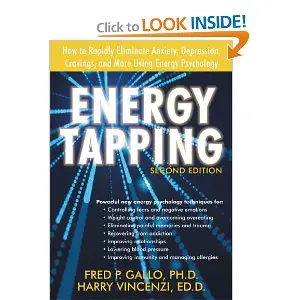The healing practice of energy tapping is far from the mainstream health world’s radar screen, but it has been known to deliver amazing results when done properly, with over 60 specific studies all concluding the same thing: energy tapping really works.
Even among a talented group of energy tapping experts, Fred Gallo stands out as one of the best in his field.
The author of the indispensable Energy Tapping resource ‘Energy Tapping: How to Rapidly Eliminate Anxiety, Depression, Cravings, and More Using Energy Psychology’ (along with Harry Vincenzi) joined AltHealthWORKS.com for a thorough discussion on why the practice holds so much promise, and the many simple solutions it offers for eliminating all manner of psychological and emotional problems.
AHW: Hi Fred, thank you for joining us. So tell us about how you got into energy healing and specifically energy tapping.
FG: Thank you. Well, I started off as a teacher and then I became a counselor before going to school to become a clinical psychologist. I studied the traditional approaches, also existential phenomenology, client-centered therapy, and Gestalt therapy. I was studying in the 60s and then I went on and studied hypnotherapy, especially the work of Dr. Milton H. Erickson, a noted physician hypnotherapist, and neurolinguistic programming. I became certified in NLP. I began working in the field, doing psychological testing and evaluations, as well as therapy; worked with individual couples and families.
At some point I got a bit bored and was open to doing something else. In 1992 I came across this article by a psychologist named Dr. Roger Callahan. The article covered treating addiction by tapping at locations on the body; it was very bizarre. I laughed after I read it; I thought “How could he think that could be a way of treating addiction?”
After a short period of time I began playing around with this approach. I was skeptical, but I started getting success with my clients, friends and relatives. He (Callahan) was a pioneer. Nobody was doing energy tapping; very few people in the country or the world knew anything about it back in 1992, even though he developed it between 1980 and 1985. He of course wrote the book, ‘Five Minute Phobia Cure: Dr. Callahan’s Treatment for Fears, Phobias and Self-Sabotage.’
We developed a good relationship, Dr. Callahan and I, and I got certified in his approach but at the same time I was developing it in my own way. With Roger’s blessing I went around the U.S. and Canada teaching people about his approach. Roger more or less taught individuals, he taught me and Gray Craig (who is known for developing emotional freedom techniques), Larry Nims…We would spend time individually, but I thought it should be taken around and made much bigger. Roger agreed, but he didn’t want to travel that much.
I did that all over the place and the next thing I knew I felt I was ready to write a book. Interestingly enough I didn’t go looking for a publisher, the publisher came to me (in 1998) for the book ‘Energy Psychology.’ Before long it became published in Germany; I was invited to Germany, Austria, and Switzerland, and I taught all over Europe; Italy and Norway. I visited a lot of different places and trained a lot of people to present this kind of material too. I coined the term energy psychology; it became an umbrella technique for doing this work (including energy diagnostic treatment methods and advanced energy psychology).
All of these approaches impact energy systems in some ways; they certainly can impact our ways of thinking and brain functioning and so on; they’re all very bodily and energy oriented, which is why I first gave it that name. The first book I wrote introduced approaches like that, including emotional freedom techniques, applied kinesiology, Tapas Acupressure Technique, energy diagnostic treatment methods, and then of course the Energy Tapping book came out.
AHW: So in regards to energy healing and energy tapping, does someone need to be physically healthy in order to get good results? And what about people who eat healthy but still don’t feel their best, can this be the missing link they’ve been looking for to finally free up more energy?
FG: Generally the healthier a person is, the more effective this or any approach. One of the most important things is that they have a healthy brain that’s functioning well. The relationship between therapist and client is highly important, and research shows that this is an important aspect of any effective therapy.
The people I’ve worked with have had good physical health and others haven’t, but the approach has worked for all of them. Although some people have more complicated problems, and EP approaches can take more time and energy in such cases.
AHW: Do you have some particular examples or studies to share?
FG: Sure, yes. One of the things about this approach is that it works especially well for trauma. If someone is having a trauma of some sort, where they’ve been a soldier in battle or in a severe auto accident, raped, or anything of this nature, then we can generally help that person very quickly with this approach.
One case that comes to mind is where a person was in a severe auto accident. She was driving down the highway and another car went across the median and hit her. All of the people in the other car were killed…The driver was intoxicated. My client became pinned under the dashboard and the car was totally crushed. They had to use the Jaws of Life to get her out. She was “life lighted” and eventually taken to a rehab center.
After a year, her mother brought her to see me, and one of the most devastating feelings she had was of being pinned under the dashboard. Other people died, she was life lighted, et cetera. All of the different aspects were affecting her (mentally).

Know a lot about health, but want to learn how to truly heal? Check out the Thrivers Lifestyle guide by clicking on the link above.
I asked her to bring to mind one of these that you would like me to treat right now and she chose being pinned under the dashboard. So I asked her to give me a rating from 1-10 as to how much it bothered her and she said, “A 9 or a 10.”
I had her put it out of her mind first of all and then started a tapping sequence. I would have her check, then tap, and said, if you could guess what would you think it would be right now?
She said it was about the same, so we did more tapping and checking. To make a long story short, after about 3-5 minutes she was able to say, “I don’t think it would bother me at all.” I said okay, take a look and really think about it. She tried again and laughed, marveling that the memory didn’t bother her. Then I said, “I don’t think you spent time thinking about it. Really try to feel upset about it.” After 10 seconds she laughed again and wanted to know how this worked! I said that I wasn’t sure it had worked yet. So I said, “Why don’t you really give it a test!” I set a timer for a minute and told her I wanted her to really try to get distressed about it.
This is not what you would usually do in therapy, but I told her to really imagine she was pinned under the dashboard, maybe in an odd contortion. I told her to remember what she could smell, maybe even feel the physical pain. After about a minute, the alarm went off and she said in amazement, “This doesn’t bother me at all anymore. How does this work?”
We’re talking about a few minutes of treatment to help with a (potentially lifelong) trauma. After the treatment, the memory never bothered her again. Generally it takes a few minutes to an entire session to resolve a single incident trauma, just by having a person tap at specific locations on the body’s acupuncture meridians that are described in my books ‘Energy Tapping,’ and ‘Energy Tapping for Trauma.’
Another gentleman was very depressed and his anti-depressant medication wasn’t helping. He still felt depressed. I gave him a test-specific test to determine his level of depression: Beck Depression Inventory (BDI). After having him tap at specific locations on his body while in the office, the feelings of depression dissipated. The next time he came in, he took the BDI again and his level of depression had come down significantly. After the third visit, he showed no signs and was able to go off his anti-depressants. Anti-depressants can sometimes help, I’m not saying they’re never useful, but in this person’s case it wasn’t and tapping made all the difference.
Physical pain is also something I specialize in. A gentleman from Wales, UK contacted me a couple weeks ago. He had severe back pain, and had surgery, injections, et cetera. He still had the back pain and I wrote back in the email one of the sequences that I find helpful for physical pain and instructed him. He wrote back to me a week later saying that the results were remarkable; nothing had helped him with his pain (note: Dr. Gallo also helped him with his asthma by phone).
AHW: Do these changes typically come about mainly because of a mental affirmation or through physical changes?
FG: It depends; some people have something called a psychological reversal, which is a block that could that prevents the tapping sequence from working. In that case, we have a person do something like this: tap on the side of the hand as if they were doing a karate chop, while saying something like, “Even though I have this problem, I accept myself…” The problem could be pain, depression, a phobia, anxiety, etc. But if they tap and say “I accept myself…” a few times, and go from there to a sequence of tapping a few different meridian points, the treatment then can work well. Sometimes just a general tapping sequence may be adequate.
Other times when someone has a more complicated problem, a general tapping sequence may not work. Then you have to get more specific, and it may take a lot longer. Sometimes it’s more important to zero in and be more precise and at other a times comprehensive sequences like EFT or the Midline Energy Treatment (MET) will be very effective. With MET, the tapping points are: forehead between the eyebrows, under the nose, under the bottom lip, and at the center of the chest. Both EFT and MET work for a variety of issues.
Let’s say the person has a feeling of depression in their body. We can tap the back of the hand between the middle and ring fingers; the triple warmer meridian. We tap there focusing on the feeling of depression then intermittently tap under the collarbone point on the kidney meridian. Over a certain period of time, this can cause the depression to remit. There are different levels of how it works; this is not a comprehensive but a focused algorithm.
Other times it’s important to diagnose specifically what the individual needs and that’s a more complex approach that you can’t really include well in a self-help book. Certain diagnostic procedures can be used figure out where is best to tap for instance. I covered much of that in my book, ‘Energy Diagnostic and Treatment Methods.’
Different reversals can come up too. A reversal may center around the issue of family loyalty for example. This person may have an issue related to something that happened in the family, an unconscious level of commitment to having this problem may be part of the norm in the family.
AHW: That sounds pretty complex, and pretty common actually. Have you been able to permanently reverse these issues?
FG: These issues aren’t permanent, it’s a matter of tracking it down, finding the source of the problem using muscle tracking. That will tell you whether or not the person has that kind of reversal. They feel that they would be “unloyal” to the family or not safe or that it’s not possible to get over it in many cases.
Once you find that reversal, it’s simply a matter of fixing it. But it’s not necessarily a permanent fix. It’s one that can be repeated time and time again giving it less of a chance of returning. There are other protocols too for tracking back to when the reversal occurred. Did it occur at a specific point in time? We can track that back personally. But if you don’t know what you’re doing, fixing these can take forever. That’s why we run these diagnostic tests; they make it very quick and to the point.
AHW: So typically from that point you’d just need to practice good maintenance so the reversal or other problem doesn’t come back?
FG: Yes, that’s right. However the thing that I find is that some situations don’t require any repeated treatment. Once we resolve, let’s say a trauma, it’s fine. That’s not surprising, it’s much less complicated.
Some people have a lot of issues, but other situations are easier. For quitting smoking, very often I can help them handle it in one or two sessions. Weight reduction, that’s a different story. It can take longer. Same with depression and panic disorder.
I don’t want people to think that energy tapping is just a quick fix, that it’s all simple and you can just say, “Tap, tap, tap, all better.” Tapping is very useful, but it’s a matter of who’s operating it. If somebody thinks they’ll get better and they don’t automatically, they can feel demoralized. It’s a matter of what’s going on with the person. The current model does have a limit as to how effective it can be; but there’s always a new horizon to something and I want to make it even more evolved. That’s what I’m working on currently.
AHW: And what does this new horizon in the world of energy tapping involve?
FG: I’m looking at a lot of the research on mindfulness and meditation and combining that with energy psychology. Peoples’ problems are often very much stress-related, and when you start to think, “I’ve got to get rid of it,” you only add more stress to the problem, and then you start to think about how terrible the situation is.
From the point of view of the brain, this is related to sub-cortical structures including the amygdala, the fight or flight mechanism. Whenever you have a problem, phobia or trauma, or severe anxiety, there’s activation in that part of the brain. During stress the ratio of blood and oxygen is higher in those areas as compared to areas where we do our best thinking, including the Pre-Frontal Cortex (PFC) behind our foreheads. When you think about how you’ve got to get rid of the problem, this adds more stress.
However when you look at things mindfully, you observe the symptoms and sensations in your body in a non-judgmental way. Everyone would like to feel better, there’s nothing crazy about that, but the reality is that the more you get caught up in yearning or demanding or desperate to feel better, this level of awareness or perception contaminates.
So instead, with mindfulness you just experience it, observe it and then start doing the tapping while observing in a non-judgmental way.
While tapping on the side of hand (karate chop), you can say something like, “Even though I have his problem (you might replace “problem” with whatever you’re treating, such as phobia or trauma), I deeply and completely love and except myself,” and maybe even add, “and the phobia too.”
Coming from that non-judgmental position will facilitate the process so much faster and deeper. Change will occur and it will be very different. The more you think that you can just tap it out and get rid of it, the more you can get stuck.
For example, I realize in my own life experience…I was 21 and got in a severe accident, I almost died and was hospitalized, lost a lot of blood and had my spleen removed. I had a panic disorder, and every time I had a panic attack I was fighting to get rid of it.
Eventually I had one that last two hours and was still persisting regardless of what I tried to get rid of it, so I laid face down on the bed and said to myself, “Go ahead and get me, I don’t care.” I took that attitude and immediately the panic dissipated; I wasn’t feeding it anymore. There I was surrendering. And then a week or two later I had the beginnings of another attack and I got this aura, this body vibration of the beginning of a panic attack, and instead of doing what I normally did which was to fight it, to pace around and take a shower or whatever, I simply closed my eyes and “went into it.”
It dissipated by mindfully observing it in a non-judgmental way. When people try to apply this approach over time they will get results and start to feel better and better.
They’ll start getting deep feelings of well-being and better emotional regulation. Whenever somebody is not activating their stress centers, they’re moving their attention to the more evolved areas of the brain and energy tapping can accelerate that process. That’s my thesis on this from my experience.
Tapping accelerates the benefits of mindfulness and mindfulness accelerates the benefits of tapping, so the two work together in a synergistic way.
With regard to mindfulness-based energy therapy, I am preparing an article that covers this in more depth. I don’t discuss the approach it quite in that way in the Energy Tapping book, although it is touched on in ‘Energy Tapping for Trauma.’
AHW: Going back to the panic attacks, did you use energy tapping to get over them on your own?
FG: Actually with the panic attacks, that was before I knew anything about (tapping). I was 27 and I resolved it in the way I mentioned previously; even if I had a headache I would “observe it” and started describing it, and it would dissipate as a result of this mindful observing approach.
AHW: I have been able to check out the Energy Tapping book, and I tried some of the exercises that seemed to work in the short term. Do you think anyone can open the book up, try them and get some benefits right away?
FG: Yeah, sure. Even though I’m a little bit contradicting myself here, if you really target something and get very specific, you can get a result. But, and here’s the contradiction, you can also tap with nothing specific on your mind and get results. If you tap on a regular basis for nothing specific in a mindful, conscious way, you can balance your energy system and also treat whatever might be cooking unconsciously at the time.
AHW: And most of the points require just five taps?
FG: Well that depends, like depression can take an extended period of time. You would tap the back of the hand between the little finger and the ring finger extendedly. You’d tap over 100 times while focusing on a sensation of depression, hollowness or emptiness of the depression, for instance.
Sometimes we’ll tap 5-7 times on each point and then check again to see where it is, and how intensive it is. That is, if you take a measure of 1-10 as to how distressing something is, after tapping you check again to see if the distress has come down, say from a 10 down to a 5, for example. Then you tap again, mindfully, and check again. Eventually the issue no longer bothers you.
AHW: Would it make sense to keep tapping every day, and to simply tap points whenever you have a chance to keep your “energies” moving? Is there any negative to tapping, per se, such as tapping the wrong points?
FG: There’s practically never any negative to tapping…although it can often neutralize a positive emotional response in some situations. But when it comes to things like releasing the feeling of depression and trauma and guilt, I don’t see any harm in releasing yourself of that, of course.
Either it will help or it won’t do anything at all. It’s nothing like a drug which could be very harmful, especially certain drugs.
AHW: Do you use energy tapping often in your daily life, on your own?
FG: I used to do it a lot and I do sometimes. Once in a while something comes up, but I don’t do it as much as I used to. I think over time you don’t need to do it as much, since you’ve cleaned up a lot of issues.
Here’s an interesting story…Many years ago, I got an idea. A weird thing happened to me while I was sleeping, I had a dream that I was down in a cellar and I saw a big rat. In my dream I felt really anxious seeing this rat, and immediately in the dream I started tapping under my eye, and my arm, etc. Then I didn’t feel anxious. I had treated myself in the dream in my mind.
I began to wonder if that really helped, would that be able to help people in general? I started doing that with myself. If I felt I was in a low mood or upset about something, I would just imagine tapping points and most of the time I found that it helped create a change.
A couple of my clients discovered that also. They told me that they found that if they just thought about tapping, it worked. They would visualize tapping the points and it worked! Quite amazing!
I’m recommending that to people now, but first of all they should physically tap until they get comfortable with that and start bringing their imagination into the equation.
There was even a study that had people tap on the meridian points of a doll, and they found that it worked. But I don’t think the researchers interpreted the results very well, since their interpretation really kind of discounted the treatment. Still, it just shows that there’s another way of doing this.
It’s like when you’re on a bus and someone starts yawning, the next thing you know, a whole bunch of people will also be yawning. It’s an empathetic response, you can find that the same thing applies to energy tapping.
AHW: Thanks for letting us know so much about this fascinating field of healing, Fred. Another question as we start to wrap this interview up, is energy tapping and are energy tapping practitioners very widespread? Where can people find out more?
FG: Well they can go to www.energypsych.com, I have a section that lists certified practitioners and the people I trained. Another site to get info on is www.energypsych.org which is the Association for Comprehensive Energy Psychology (ACEP)
AHW: Great, and another thing, what are some energy healing techniques that you also are a fan of besides energy tapping? Are they as effective?
FG: There are many other effective approaches, but I don’t think they’re as efficient as energy tapping. But I’m not going to discount them. You’ve got Qi Gong, which is like a general energy balancing kind of approach, and other similar methods…The granddaddy is from Roger Callahan which is Thought Field Therapy (TFT), also you’ve got Emotional Freedom Techniques (EFT). There are a lot of variations of those which are very effective.
AHW: And of course emotional freedom, or rather a lack thereof in someone’s life, can factor into a wide variety of diseases, correct?
FG: Yes, oh yes. Ongoing emotional distress also impairs your immune system and makes you vulnerable to disease. Tapping can help to improve your emotional and also physical health and freedom. Unfortunately Energy Psychology and Emotional Freedom Techniques have often been categorized as pop psychology, becoming superficialized in some ways through some videos and other materials that are sold to a wider audience.
(But legitimacy for EFTs is now growing in the mainstream health community, Gallo noted).
The Psychological Association didn’t approve of any kind of training in energy psychology until just this year. The Association for Comprehensive Energy Psychology is now offering continuing education credits in Energy Psychology to psychologists, and this is moving it to the mainstream and making sure it’s not just some sort of fluke.
I cover some of the key research on energy tapping in my books, and more research has been coming out all the time, probably approaching sixty studies, proving the benefits of energy tapping. Several have been randomized controlled trials. This really shows the power of the approach, and it’s getting increasing scientific support.
AHW: I was definitely impressed with a lot of the information about the studies in the opening part of the book. Would you recommend that people pick up the book if they’re new to energy tapping and want to try it out for themselves?
FG: I may be a little prejudiced but I think it’s a good book. It lays out a lot of information for a variety of conditions for yourself. There are others such as David Feinstein’s ‘The Promise of Energy Psychology’ too.
But overall, I think my book ‘Energy Tapping (Click here to get a copy)’ is one of the better books in the field.
AHW: I know I’ve certainly enjoyed it and learned a lot from it. Thanks a lot for your time Fred, and we’ll talk to you again soon.
FG: Thank you very much for having me.
Thanks for installing the Bottom of every post plugin by Corey Salzano. Contact me if you need custom WordPress plugins or website design.













